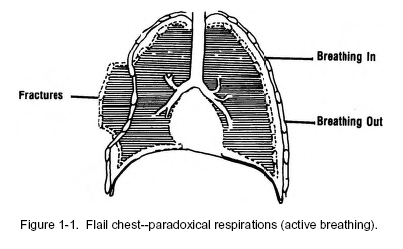|
CORRESPONDENCE
COURSE
U.S. ARMY MEDICAL DEPARTMENT CENTER AND SCHOOL
SUBCOURSE MD0569 EDITION 200
CHEST AND AIRWAY PROBLEMS
In this subcourse, you will study chest and airway problems. Chest
trauma refers to general information about chest injuries as well as
information about specific chest injuries. Airway problems includes
information on devices -- nasopharyngeal airway (NPA), the Combitube™
and KING LT-D™ airway [which are both BIADS (blind insertion airway
devices)], and the endotracheal tube (ET) -- that can be used to open
and maintain an airway.
If other life-saving methods are not successful in opening and
maintaining an airway, an opening is made in the trachea to bypass the
site of an upper airway obstruction. This subject matter is of vital
importance in saving lives.
----------------------
Length: 55 Pages
Estimated Hours to Complete: 8
Format: PDF file
Size: 0.8 MB
----------------------------
Anyone may take this course. However, to receive credit hours, you
must be officially enrolled and complete an examination furnished by
the Nonresident Instruction Branch at Fort Sam Houston, Texas.
Enrollment is normally limited to Department of Defense personnel.
Others may apply for enrollment, but acceptance is not guaranteed.

Chest and Airway Problems
Distance Learning
Course
55 Pages
Est. 8 Hours
0.8 MB pdf file
Download Now |
|

TABLE OF CONTENTS
INTRODUCTION
1 CHEST TRAUMA
Section I General Information About Chest injuries.
Section II Specific Chest Injuries
Section III Chest Decompression
Exercises
2 AIRWAY MANAGEMENT
Section I Esophageal Obturator Airway
Section II Endotracheal Tube
Exercises
3 CRICOTHYROIDOTOMY
Section I General Considerations
Section II Needle Cricothyroidotomy
Section III Surgical Cricothyroidotomy
Exercises
-----------------------------------------------------
LESSON 1
CHEST TRAUMA
Section I. GENERAL INFORMATION ABOUT CHEST INJURIES
1-1. INTRODUCTION
Chest injuries are of major importance because they
are a common cause of death. Fifty percent of the people who expire
from chest injuries die on the way to the hospital. The common causes
of penetrating and nonpentrating chest injuries include automobile
accidents, falls and blows, gunshot wounds, stab wounds, and crushing
injuries. In a chest injury, there is a possibility of internal
bleeding and/or direct injury to the heart or lungs; therefore, any
chest injury may be serious. Chest decompressions, field functions,
and other procedures may be used to save the casualty's life if they
are performed correctly and in a timely manner. With specialized
training and prescribed methods of treatment for various chest trauma,
your ability to recognize and react quickly in each situation is an
important factor in regard to whether the casualty survives.
1-2. COMMON SIGNS/SYMPTOMS OF CHEST INJURIES
The common signs and symptoms of chest injuries are:
a. A change in normal breathing pattern.
b. Pain at the site of the injury.
c. Dyspnea (shortness of breath).
d. Failure of the chest to expand.
e. A rapid/weak pulse.
f. Low blood pressure.
g. A dry cough or blood.
h. A sucking sound on respiration.
i. Cyanosis (bluish discoloration of the skin due to
lack of oxygen).
j. Hemoptysis (spitting of blood from lesions in the
larynx, traches, or lower respiratory tract).
1-3. COMMON TREATMENT FOR CHEST INJURIES
Regardless of the type of chest injury, initial
treatment is almost always the same. Begin by examining the casualty
to detect the chest injury.
a. Question the casualty, if he is conscious, to see
if he has difficulty in breathing.
b. Observe the casualty's bare chest and upper
abdomen for respiratory rate and depth.
c. Check for equal movement of both sides of the
casualty's chest.
d. Examine the entire chest wall (including the
back) beneath any overlying clothing.
e. Listen to the casualty's chest with a
stethoscope. Listen to both sides of the chest, comparing both sides
for volume, loudness, and equality.
1-4. TYPES OF CHEST INJURIES
a. Penetrating
Injuries. A penetrating injury may be a hole in the thoracic
cavity that allows air inside the thorax, the air filling the
thoracic cavity (pneumothorax). A penetrating injury may cause blood
to flow into the thoracic cavity (hemothorax), filling the thorax
with blood.
b. Blunt Injuries.
These are blunt injuries: rib and sternum damage; flail chest; and
cardiac contusion.
c. Results of
Penetrating/Blunt Injuries. Penetrating and blunt injuries can
cause considerable damage. Both types of injury can cause air to
build up outside the lung in the thoracic cavity, and the individual
has simple pneumothorax. The pressure has not been great enough to
cause the lung to collapse. A blunt injury or a penetrating injury
may cause air to build up to such great pressure in the thoracic
cavity that the lungs collapse. Tension pneumothorax is the name of
this condition.
1-5. GENERAL PRINCIPLES OF TREATMENT FOR CHEST TRAUMA
Follow these general principles in treating for chest
trauma:
a. Maintain normal pleural pressure by the use of
suction devices throughout the treatment. Keep the pleural space empty
by using suctioning devices such as hemovac or pleuralvac. Monitor the
suctioning device frequently, regardless of which device is used.
b. Monitor the casualty for pericardial tamponade.
This condition, which will be discussed later, is caused by
penetrating chest wounds such as gunshot wounds or stab wounds. The
result of the condition can be diminished cardiac output and finally
death; therefore, it is extremely important to watch for signs of
pericardial tamponade in the person.
c. Keep the bronchial tree clear of retained blood,
foreign material, and bronchial secretions by using suction as needed.
d. Give oxygen to maintain adequate oxygenation and
removal of carbon dioxide. If oxygen administered by nasal catheter is
inadequate, use tracheal intubation, cricothyroidotomy, or controlled
positive breathing.
e. Estimate the amount of hemorrhage the casualty has,
and replace the blood as necessary.
From Chest
and Airway Problems |


